June 24, 2022
Air Date: June 24, 2022
FULL SHOW
SEGMENTS
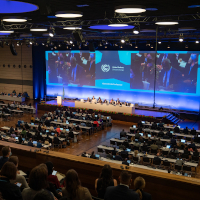
UN Climate Talks On Hot Seat
View the page for this story
With heat waves, fires and drought raging around the world, UN climate negotiators recently gathered in Bonn, Germany to prepare for the next climate summit this fall in Egypt, but these talks are not moving as fast as climate disruption itself. Alden Meyer, a 30-year veteran of climate conferences, joins Host Steve Curwood to discuss the session, including the hot topic of financial assistance for poor nations. (08:54)
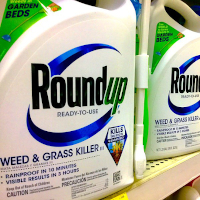
Beyond the Headlines
/ Peter DykstraView the page for this story
Environmental Health News editor Peter Dykstra and Host Steve Curwood discuss the decision by the US Court of Appeals for the Ninth Circuit ordering the EPA to reexamine the health and environmental risks of glyphosate, the key ingredient in the weed killer Roundup. They also marvel at the potential of urine as a cheap and environmentally-friendly fertilizer before looking back at climatologist James Hansen’s 1988 testimony in front of Congress on a hot day that raised public awareness on global warming’s causes and consequences. (04:37)
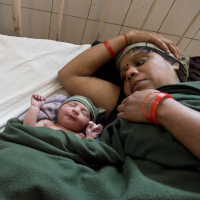
Pregnancy and Heat Waves
View the page for this story
Extreme heat events such as India and Pakistan recently endured are among the deadliest impacts of climate change, and pregnant women and fetuses are among the most vulnerable to heat stress. Cecilia Sorensen, director of the Global Consortium on Climate and Health Education at Columbia University, joins Host Bobby Bascomb to discuss the research on how extreme heat is linked to complications of pregnancy including eclampsia, preterm birth and stillbirth. (09:37)
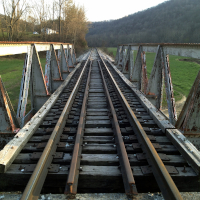
Putting Coal Miners Back to Work
View the page for this story
To help revitalize Appalachia as coal mining dries up, the United Mine Workers of America is teaming up with an electric vehicle battery company to bring the lithium-ion battery industry to West Virginia. Host Steve Curwood talks with Erin Bates of the United Mine Workers of America about how unemployed coal workers and miners are looking forward to jobs in the clean energy transition. (07:44)

Note on Emerging Science: A Sign of SIDS Risk
/ Delaney DryfoosView the page for this story
Sudden Infant Death Syndrome or SIDS takes the lives of more than 1,000 infants in the United States every year. Living on Earth’s Delaney Dryfoos reports on new research that has identified a biochemical marker in the blood of newborn babies that suggest why some babies are more vulnerable and might one day help screen for SIDS risk. (02:05)
Gotta Getta Fish!
/ Mark Seth LenderView the page for this story
Living on Earth's Explorer in Residence, Mark Seth Lender, shares the story of a juvenile osprey striking out on his own to find his first meal not delivered from his parents' beaks. (02:59)
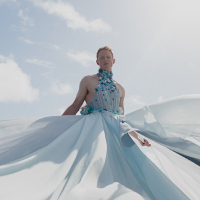
Hiking in 6-Inch Heels
View the page for this story
Growing up as a queer person, photographer Wyn Wiley was often told: The great outdoors is for everybody, but only if you look and act a certain way. Now, he works to break down this barrier. His drag queen alter-ego, Pattie Gonia, hikes in 6-inch heels and a full face of makeup, preaching on Instagram that enjoying the outdoors transcends gender identity and sexual orientation. Wyn Wiley speaks with Bobby Bascomb as Pattie to discuss her journey as a queer environmental activist and the solace she finds in nature. (10:29)
Show Credits and Funders
Show Transcript
220624 Transcript
HOSTS: Bobby Bascomb, Steve Curwood
GUESTS: Alden Meyer, Cecilia Sorensen, Erin Bates, Pattie Gonia
REPORTERS: Peter Dykstra, Mark Seth Lender, Delaney Dryfoos
[THEME]
CURWOOD: From PRX – this is Living On Earth.
[THEME]
CURWOOD: I’m Steve Curwood.
BASCOMB: And I’m Bobby Bascomb.
An EV battery factory in West Virginia could bring much needed jobs to an area hit hard by the collapse of coal.
BATES: So initially they are going to bring in 300 jobs into the Appalachian area, but they are expecting for that to rise up to about 1,000 to 3,000 jobs just from that one gigafactory that they're building in West Virginia. So, we're really excited about it.
CURWOOD: Also, extreme heat events boosted by climate change are linked to maternal health concerns.
SORENSEN: We know that pregnant women, who are exposed to heat can suffer higher rates of preterm deliveries, other birth complications like pre-eclampsia and eclampsia. And the newborns can have higher risks of complications in the prenatal period.
CURWOOD: That and more this week on Living on Earth – Stick Around!
[NEWSBREAK MUSIC: Boards Of Canada “Zoetrope” from “In A Beautiful Place Out In The Country” (Warp Records 2000)]
[THEME]
UN Climate Talks On Hot Seat
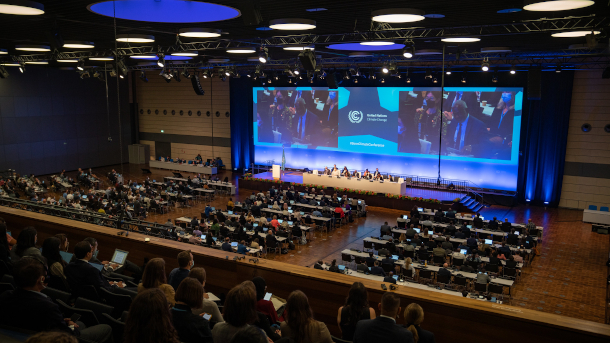
The Bonn Climate Change Conference is a crucial stepping-stone between the 2021 COP26 in Glasgow, Scotland and COP27, to be held in Sharm el-Sheikh, Egypt in fall 2022. (Photo: Unclimatechange, Flickr, CC BY 2.0)
BASCOMB: From the Jennifer and Ted Stanley studios at the University of Massachusetts, Boston, this is Living on Earth. I’m Bobby Bascomb.
CURWOOD: And I’m Steve Curwood. As more record-breaking heat waves, wildfires and drought continue to increase thanks to climate change, U.N. climate negotiators recently gathered in Bonn, Germany to prepare for the next climate summit this fall in Egypt, but these talks are not moving as fast as climate disruption itself. Alden Meyer is a senior associate of E3G who has attended these negotiations for more than 30 years. And while he notes there’s been some progress, there’s still a fundamental divide between rich and poor nations that is keeping climate protections from advancing fast enough to avoid more disasters. Alden Meyer joins us now. Welcome back to Living on Earth!
MEYER: Thanks, Steve, great to be with you again.
CURWOOD: What's the importance of intermediary conferences like what just happened in Bonn, Germany? Why should we be paying attention?
MEYER: Well, these are the working level conferences that prepare for the big annual climate summits. Last annual summit was in Glasgow, the next one will be in Sharm el Sheikh, Egypt. And this is when countries get together to work out the draft, negotiating text and decisions to forward into that process for adoption at the annual COP. It's essential to make the process work.
CURWOOD: This process helps deal with some of those devilish details?
MEYER: Yeah, that's true. And negotiators are a bit at sea because we're now making the transition from negotiation of the international climate framework, and we're shifting into implementation. How do you live into the commitments that countries have made? Importantly, how do you increase ambition to have any chance of staying below one and a half degrees Celsius temperature rise? How do you move markets? How do you get deployment of clean energy technologies at scale? And in some cases, that's not the skill set that these negotiators have. They have to play a key role in preparing the draft decisions for considerations by ministers at the annual climate summits. Really, we need people coming in, to bring in that real-world perspective, to say what is it that national governments can do to advance the agenda on radical decarbonization as is needed to cut emissions by 45% or so over the next eight years? And then, a major focus of this meeting in Bonn was how do we do a better job of helping the vulnerable countries and communities that are on the front lines of climate change, in most cases through no fault of their own, but they're experiencing horrendous impacts and the system is broken, in terms of giving them support.
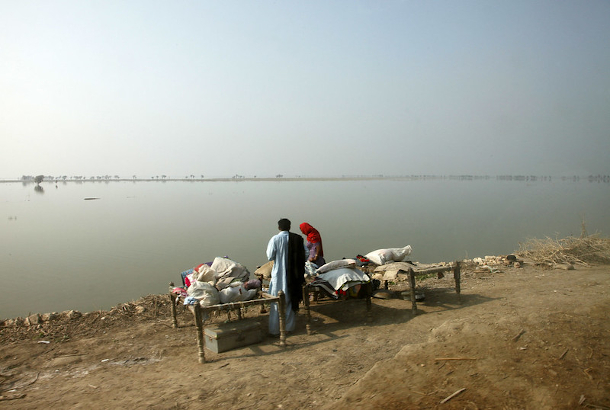
Despite barely reaching 9% of the world’s average carbon emissions, developing nations often bear the brunt of climate change-related disasters. (Photo: Russell Watkins, UK Department for International Development, Flickr, CC BY 2.0)
CURWOOD: One of the focuses of Bonn was on this question of loss and damage. Vulnerable nations have requested help from developed countries to protect themselves in the face of all the things that climate disruption is bringing. But at the bottom line, there's not a whole lot of money that's been offered. What if anything changed this time around at Bonn?
MEYER: Well, first, to unpack a little bit, there's sort of three pillars of the international regime. The two that we're most familiar with are mitigation and adaptation. Mitigation is doing as much as you can to reduce emissions. Adaptation are the investments you make to make your systems more resilient to climate change. But even if you had the best mitigation and adaptation strategies in place, the fact that we have done much too little over the last 30 years to address the crisis means we are going to experience increasing impacts no matter what we do at this point. So that's where loss and damage comes in. It's saying what can you do to respond to them? There's different kinds of impacts you're talking about. There's what are called sudden impacts such as floods or hurricanes, and typhoons. And there's what is called slow onset impacts, like sea level rise, desertification, drought. The message we got out of the three dialogues on loss and damage in Bonn was an acknowledgment that the system is broken, that these impacts are real, that they're growing. And that vulnerable countries can't really cope with them with the resources they have. And that the current patchwork of humanitarian disaster and climate finance vehicles is not working. It's not generating the quality of finance, in many cases, it's loans rather than grants. And there are huge access issues for countries to jump over. The fight in Bonn was over whether or not there should be a formal agenda item at the climate summit in Sharm el Sheikh to address how do you fix a broken finance system when it comes to loss and damage? And there it was very polarized around North South lines. The developed countries are still resisting having that conversation, although some of them such as Canada and New Zealand and others are acknowledging that we need to find a space to have that discussion.
CURWOOD: Alden, I'm scratching my head. I mean, how do you fix something unless you talk about it and get together and figure it out?
MEYER: Well, this is a long standing faultline in these negotiations. And this is not a new issue, loss and damage has been on the agenda since the original negotiations of the Rio treaty in 1992. And that's because it does involve a fair amount of money, billions, tens of billions, maybe hundreds of billions of dollars to really address and no one wants to be a situation where you divert money from mitigation or adaptation to fund loss and damage. And of course, there's a concern that this could create open ended liability for compensation for the historical emissions. By and large, it's the Western, Northern countries that have been responsible for the bulk of the carbon put into the atmosphere. So that's where the resistance has come from. But I would say there's been an evolution. They're saying we have to talk about this. Now we're acknowledging it's broken. Let's find ways to make the system more responsive to the needs of vulnerable countries without creating a new financial facility.
CURWOOD: Speaking of mitigation, the poorest parts of the world will need large quantities of energy to develop and prosper. But it means that developing countries gotta look to the cheapest stuff, typically coal to meet their energy needs.
MEYER: Yeah, the good news is that with the dramatic reduction in the cost of photovoltaics, wind turbine storage technologies, etc. a clean energy pathway is more affordable than coal or natural gas or fossil fuels. The problem is, it has greater upfront capital costs. The International Energy Agency last year did a report saying that to get developing economies on a path compatible with staying below one and a half degrees Celsius temperature increase, we would need to increase finance for clean energy deployment from the current 150 billion a year to $1 trillion a year by 2030. And actually, the G7 leaders acknowledge that last December when they launched the Partnership for Infrastructure and Investment. And we're now calling on them at their summit in Germany next week to come up with ways to generate that kind of mobilization of resources. There's a lot of work to do there. And of course, the good news is, as I said, the cost is coming down. The bad news is generating that money is not an easy task in the international financial landscape.
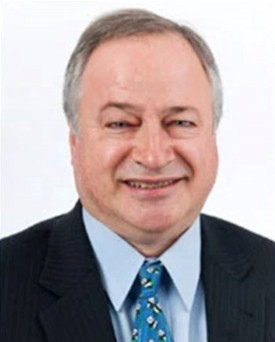
Alden Meyer is a Senior Associate at E3G working on US and international climate policy and politics. He is a Principal at Performance Partners, which provides a range of consulting services to clients in government, business, and the non-profit sector. (Photo: Courtesy of Alden Meyer)
CURWOOD: How do you think energies among delegates have changed over the 30 years these negotiations have been going on?
MEYER: I would say, there was a lot of polarization in Bonn on some of these issues like loss and damage, but it was very workman like, I mean, there's collaboration and sort of empathy. They respect each other. Countries come in with negotiating instructions for their delegates, and they really don't have the ability to cross those red lines and make compromise deals. That really is what the ministers have to do. But I would also say on a personal level, just talking to a number of them, they're frustrated. They're frustrated by the big power dynamics. They're frustrated by some of the fossil fuel industry's disinformation. But they roll up their sleeves, and they determined to get the job done.
CURWOOD: How prepared are we? How prepared is the world for COP 27 in November in Sharm el Sheikh?
MEYER: Well, I think there's a lot of work to do. Everyone's waiting to see what the incoming Egyptian presidency of the Conference of the parties intends for their priorities and their agenda. So, I don't expect COP 27 to be the kind of high-profile big bang COP that Glasgow was. But this one has to build on those gains, develop accountability standards to measure how well countries and companies and sub-national actors are doing. And we really need to scale up the work on addressing climate impacts. And I know that's going to be a priority for the Egyptians. And this is seen as sort of the Africa COP and the impacts on the African continent are more severe than in many other regions in the world. So, I'm sure that will be front and center but it’s a very difficult space given the sums of money that are involved to really address it meaningfully.
CURWOOD: Alden Meyer is a senior associate with E3G and a longtime veteran of the U.N. climate negotiations. Alden, thanks so much for taking the time with us today.
MEYER: It was great to talk to you Steve.
Related links:
- Alden Meyer’s E3G profile
- United Nations Press Release about Bonn’s conclusions
- Summary from Carbon Brief about key Bonn takeaways
[MUSIC: Lawrence Blatt, “The Color of Sunshine” on The Color of Sunshine, by Lawrence Blatt, Pacific Jazz]
Beyond the Headlines
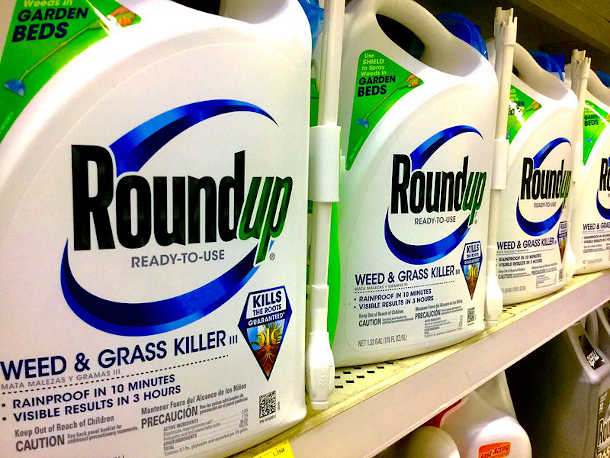
The EPA has been ordered to reexamine the health and environmental risks of glyphosate, the key ingredient in the widely used herbicide Roundup (Photo: Mike Mozart, Flickr, CC BY 2.0)
CURWOOD: Well, these days the news cycle is so fast and furious that a lot of things can get by us. Unless, of course, there's Peter Dykstra looking out for the things beyond the headlines that we ought to know. Peter is an editor with Environmental Health News, that's EHN.org and dailyclimate.org. And he's on the line now from Atlanta, Georgia. Hi, there, Peter. How are you doing today?
DYKSTRA: Hello, Steve. I'm doing well. And there's a story in the news last week that the U.S. Court of Appeals based in California has said that the U.S. EPA has to go over the risks of glyphosate, the key ingredient in the weed killer Roundup. Roundup is owned by chemical pharmaceutical giant Bayer. So that's going to put EPA back to the drawing board on researching whether glyphosate causes cancer and threatens endangered species.
CURWOOD: Yeah, I think the EPA had reauthorized this stuff towards the end of Mr. Trump's time in office, much to the consternation of environmental groups.
DYKSTRA: They did even though the European Union and others think glyphosate is dangerous and have taken action to restrict it. But the appeals court doesn't have any impact on whether Americans can buy, sell and use glyphosate. Farmworkers use it and homeowners use it for lawn and garden. But it is going to take another look at something that's also been extremely contentious. There are suits that have been decided for tens of millions of dollars, one just upheld by the U.S. Supreme Court for a $25 million verdict to a homeowner on the West Coast who says his cancer is a result of using glyphosate for years. There are also a lot of cases from agricultural workers who use glyphosate pretty much every day during the growing season.
CURWOOD: All right, Peter. What else do we have today?
DYKSTRA: Peecycling is a new term. Pee is being collected to be used as fertilizer. There are efforts on in places as diverse as Vermont and the African country of Niger, because human urine has essentially the same nutrients in it for crops that chemical fertilizers have, and chemical fertilizers can be a lot nastier to the environment in their manufacture.
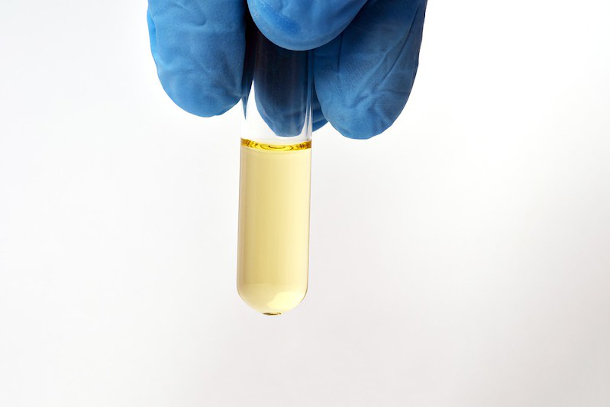
Urine is considered by some as a widely available and environmentally safe alternative to chemical fertilizers (Photo: Diverse Stock Photos, Flickr, CC BY-NC 2.0)
CURWOOD: Let me see. So, we must have phosphorus. We must have nitrates and other nutrients. But cut to the chase here, Peter. I mean, how do you gather all this pee up?
DYKSTRA: People will find a way. Human poop is already used as an ingredient in fertilizer that comes from a lot of our major city sewage treatment plants. But there may be a bigger global effort to turn our waste products into money and not let our waste go to waste.
CURWOOD: Okay. What do you have from the history books for us today?
DYKSTRA: June 23, 1988, a NASA scientist named James Hansen appeared before a U.S. Senate committee chaired by Senator Al Gore and talked about climate change and its potential impacts. It's when America first sat up, or sat down, and took notice of how bad climate change impacts could be.
CURWOOD: Yeah, I even remember that, Peter, and it was a brutally hot day in Washington. It's almost as if Vice President Gore had ordered up the weather to tell this story.
DYKSTRA: Maybe it was a convenient truth. But both men, Gore and Hansen, came to national and international renown. They were very prominent on the issue. They still are.
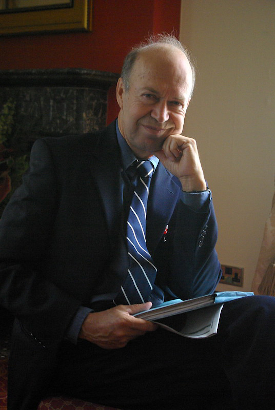
NASA scientist James Hansen made history in June 1988 with his widely publicized congressional testimony on the causes and consequences of climate change (Photo: Global Justice Now, Flickr, CC BY 2.0)
CURWOOD: Let's see. Al Gore got part of a Nobel, an Emmy, a Grammy.
DYKSTRA: But both men also got a tremendous amount of grief.
CURWOOD: Yeah, but they did get the science overwhelmingly correct, Peter.
DYKSTRA: And here we are thirty-four years later, two men and many others vindicated on the science, but we're still staring into the abyss with so much more to be done to try and stop the damage from climate change.
CURWOOD: Yeah, and sadly, thirty-four years later, we have a heck of a lot less time to try to turn things around and deal with the emergency.
DYKSTRA: That’s correct.
CURWOOD: All right, Peter, let me thank you for bringing us all this news. Peter Dykstra is an editor with Environmental Health News, that's EHN.org and dailyclimate.org, and we'll talk to you again real soon.
DYKSTRA: All right, Steve, thanks a lot and we'll talk to you soon.
CURWOOD: And there's more on these stories on the Living on Earth webpage. That's LOE.org.
Related links:
- The Guardian | “US must re-examine risks of glyphosate, key Roundup weedkiller ingredient”
- The New York Times | “Meet the Peecyclers. Their Idea to Help Farmers is No. 1”
- Yale Climate Connection | “Judgment on Hansen’s ‘88 Climate Testimony: ‘He was Right’”
[MUSIC: Tracy Chapman, “Fast Car” on Fast Car, by Tracy Chapman, Elektra]
BASCOMB: Coming up – From India to Indiana, record breaking heatwaves are rolling across the planet with special risks for pregnant women and maternal health.
ANNOUNCER: Support for Living on Earth comes from Sailors for the Sea and Oceana. Helping boaters race clean, sail green and protect the seas they love. More information at sailorsforthesea.org. Support also comes from Friends of Smeagull the Seagull and Smeagull’s Guide to Wildlife. It’s all about the wildlife right next door to you! That’s Smeagull, S - M - E - A - G - U - L - L, SmeagullGuide.org.
[CUTAWAY MUSIC: Osland Saxophone Quartet, “Cityscapes” on Commission: Impossible, by Rick Hirsch, Sea Breeze Jazz]
Pregnancy and Heat Waves
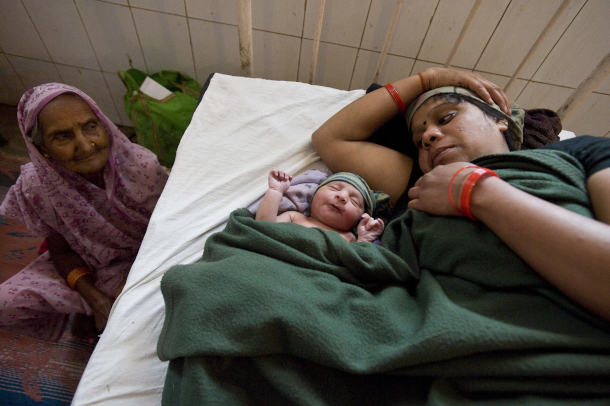
A mother and her newborn baby in Northern India, where temperatures reached a record-breaking 120 degrees Fahrenheit in the spring of 2022. (Photo: Nick Cunard, Department for International Development, Flickr, CC BY-NC-ND 2.0)
CURWOOD: It’s Living on Earth, I’m Steve Curwood.
BASCOMB: And I’m Bobby Bascomb
Heat waves are some of the deadliest and growing impacts of climate change and public health experts now attribute more than a third of heat-related deaths to climate disruption. And women bearing children are among the most vulnerable to heat stress and the polluted air that often comes with it. For pregnant women in parts of the United States and Europe, where heat waves struck this year even before the summer solstice, an estimated 90% of them could seek relief in air conditioning. But for pregnant women who had to endure the recent record-breaking heatwave in India and Pakistan, with temperatures of up to 122 degrees Fahrenheit, just 5 to 10% had access to air conditioning. Some complications in pregnancy are directly related to extreme heat. For details we turn now to Cecilia Sorensen, director of the Global Consortium on Climate and Health Education at Columbia University. Welcome to Living on Earth, Cecilia!
SORENSEN: Hello Bobby, it's great to be here today.
BASCOMB: Well, let's start with this acute example of a heat wave in India. It was more than 120 degrees this spring, their hottest May since they began keeping records. How did that heat affect pregnant people there? You know, what are some of the health concerns associated with extreme heat during pregnancy?
SORENSEN: That's a great question. We know that pregnant women who are exposed to heat can suffer higher rates of preterm deliveries, other birth complications like pre-eclampsia and eclampsia, and the newborns can have higher risks of complications in the prenatal period.
BASCOMB: I believe there's been, you know, dozens of studies looking at heat and maternal health, including an Australian study that found a 46% increase in stillbirths during heat waves. That's a shocking number. I mean, that study was a bit of an outlier from what I understand. Others found more on the order of a 5% increase for premature births and stillbirths for every one degree increase in temperature. In any case though, it seems clear that there's a very strong relationship here.
SORENSEN: Yeah, absolutely. And I think those studies are really important and really speak to the fact that, you know, our systems designed to protect women's health and protect public health during heat waves are incredibly variable around the world, right. So, we can see modest impacts in certain places and really high impacts in other places. But in general, the picture is incomplete. And we also know that, you know, the risk for pregnancy depends on the trimester that the woman is affected, right. And so, there's a lot more information that we need to understand when we're thinking about the individual vulnerability of a person being exposed to a heat wave.
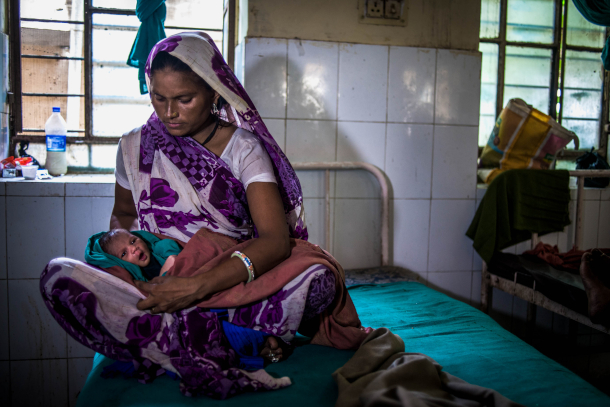
A mother with her newborn in a government hospital in Rajasthan. (Photo: Poulomi Basu, Children's Investment Fund Foundation, Flickr, CC BY-NC 2.0)
BASCOMB: I mean, you see pregnant women in the summer, and my heart just goes out to them. Being a mother of two, I know what that feels like. I cannot imagine what that feels like in 120-degree heat and unable to get cool.
SORENSEN: The scope of this is really hard to comprehend, I completely agree with you. And then when we think about heat, also being coupled with air pollution issues, which we know are rampant and are worsened by heat, you sort of have this double burden that occurs in many places with heat and with poor air quality, especially in relationship to burning of fossil fuels in urban areas, as well as wildfires, which we know also happen during the summers when we're seeing these heat waves.
BASCOMB: Well, that makes perfect sense. And I would think also, you know, so the poorest people that can't afford air conditioning might very well be also the people that can least afford to take time off when they are, you know, in stress during pregnancy. Do you see that as a problem also?
SORENSEN: Yeah, absolutely. I think especially with the informal labor sector that is very prevalent in India, that people are living on what they're making every day, you know, selling fruits and vegetables in the street or any other type of informal labor that they're engaged in, where if they are not going out and making money every day, that literally results in not being able to eat, and then we know that, you know, not having proper nutrition during pregnancy creates a whole other host of potential health outcomes for women.

A newborn baby in a hospital in Sanganer, Jaipur. (Photo: Poulomi Basu, Children's Investment Fund Foundation, Flickr, CC BY-NC 2.0)
BASCOMB: Well, that's the thing too. I mean, extreme heat can be terrible for agriculture. And I understand that that's what's happened in India, the wheat harvest was really awful. As a result, as you said, you know, women need to eat properly during pregnancy. How concerned are you about these types of food shortages compounding complications for pregnant women?
SORENSEN: Yeah, I think that's a big deal. And again, I think the scope of this is a little bit unclear. You know, we see that during these extreme heat waves that the wheat harvest and other harvests were greatly affected. And so that's going to decrease just the availability of food. And because it's economically unviable for people to purchase food because the prices go up. We also can think about women as they are engaged in the agricultural sector. So for example, a lot of women are farmers, right. And so, they are also less likely to have crop insurance, and less likely to be able to have that buffer when their crops get destroyed. And so, there's some cultural and political issues that can compound that risk of food insecurity because it directly affects women's livelihoods and their ability to be reimbursed when there is large scale crop failure. And then also the cost of food making it inaccessible for women who are already experiencing impacts from poverty.
BASCOMB: Now, we've been talking about India here, but globally, temperatures are rising with climate change and scientists tell us to expect more increased temperatures in the future. Looking big picture worldwide, what other regions of the world are you most concerned about when it comes to maternal health and heat? Both now and looking forward?
SORENSEN: I'm concerned about it everywhere, Bobby. You know, I think that there is really a lack of awareness about the impacts of heat on women and especially on pregnant women. You know, this isn't something that we learn about in medical school or nursing school, we don't have a lot of public health warnings about it, and we don't see, you know, doctors counseling patients on this. And so that's one of my biggest concerns is that we don't have a great awareness of this among health professionals everywhere, but of course, there's pockets of vulnerability everywhere in the world, right. So, I think it's, it's hard to say that there's one region that I'm most worried about because we see pockets of vulnerability, you know, even in very high resource countries, especially where there's urban heat islands that really compound the impacts of heat.
BASCOMB: I would think, you know, parts of Africa might be very vulnerable, you know, East Africa is experiencing this terrible drought right now, which is a problem in its own right. But of course, you know, if you take a hot, dry place, add climate change, make it hotter and drier, it's easy to see how that could be very, very concerning.
SORENSEN: Oh, absolutely. And, you know, heat is just one of the exposures that we're thinking about, you're also thinking of the impacts of decreased water availability and how that can impact women's health in terms of, you know, their access to proper sanitation and hygiene, especially during vulnerable periods around pregnancy and menstruation, and then thinking about the food availability, right. So, it becomes a complicated sort of multi exposure issue very quickly. But as you mentioned, yes. I'm very concerned about places like Africa, where we're seeing large scale drought coupled with these rising heat waves.
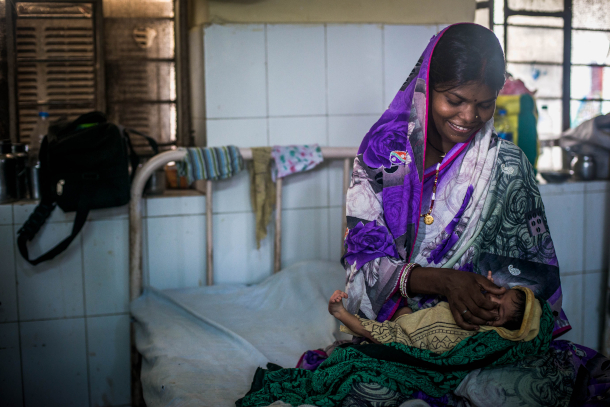
A mother with her second daughter in the District Hospital Karauli. (Photo: Poulomi Basu, Children's Investment Fund Foundation, Flickr, CC BY-NC 2.0)
BASCOMB: And what about increased risk for disease and infection for pregnant people during heat waves? From what I understand, pregnant women are more vulnerable to things like malaria and some diseases that they might otherwise be able to fight off?
SORENSEN: Well, we know that risks of water and foodborne diseases go up in the acute and sort of aftermath of heat waves. And so obviously, you know, getting any type of water or foodborne illness, when you're pregnant, or very young, that's not going to be great for your outcomes, it's gonna, you know, accelerate dehydration, cause stress, and all those things are not great for pregnancy. So, we see spikes in vector borne diseases, both in periods of drought and in periods of heavy precipitation. And that's what we're seeing with climate change is really an amplification of these two extremes, both of which, on the end of the spectrum can lead to higher risks of vector borne diseases like malaria, like dengue, which both have known pretty significant impacts on pregnant women.
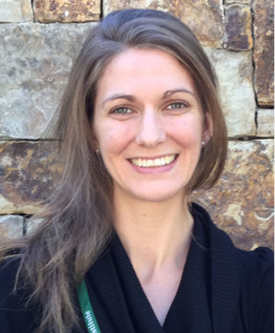
Cecilia Sorensen is an Associate Professor of Environmental Health Sciences at the Columbia University Medical Center. (Photo: Courtesy of Columbia University)
BASCOMB: So, we know that extreme heat is a big concern for maternal health. And we know that the problem is only going to get worse in the future with climate change. So, what can be done? You know, how can we safeguard the health of the most vulnerable people in our societies? You know, pregnant women and babies?
SORENSEN: That's a great question, Bobby. You know, I think there's many things we can do. I think, first, we really need to increase awareness of this issue among health professionals and not just OBGYNs, right. You know, they do see a lot of pregnant women, but we also see pregnant women in emergency departments and primary care clinics and subspecialty clinics. So, I think it's raising awareness throughout the health professional workforce to understand what the risks are to women. We also need to be thinking about public health messaging, right, when there's a heat wave, are we talking specifically about who's vulnerable, how they're vulnerable, and what they can do about it, right? So I think, to really get that going, we really need to be thinking about how we're educating health professionals about this issue so that they are aware, and they can do all those great things that public health and clinical medicine does when there is a threat to the health of a certain vulnerable group. I think we also need to ensure participation of women when we're talking about solutions, right? We can't assume that we know what's best in a community for how women can stay cool. We need to be thinking about how we can engage these vulnerable groups of women to ask them, what would be helpful for you to stay cool, right? There was some really interesting work done in northern Manhattan, where we know there's urban heat islands, and when you ask community members, you know, they have great solutions, like let's keep the pools open later, you know, let's install public water fountains. You know, really not high, economically intensive solutions but things that really help people at the community level.
BASCOMB: Cecilia Sorensen is the director of the Global Consortium on Climate and Health Education at Columbia University. Cecilia, thank you so much for your time today.
SORENSEN: Thank you so much for having me here.
Related links:
- Learn more about the Global Consortium on Climate and Health Education
- Learn more about the association between heat waves and perinatal health
[MUSIC: Santana, “Maria Maria” on Supernatural, by W.Jean, J.Duplesses, C.Santana, K.Perazzo & R.Rekov, Arista]
Putting Coal Miners Back to Work
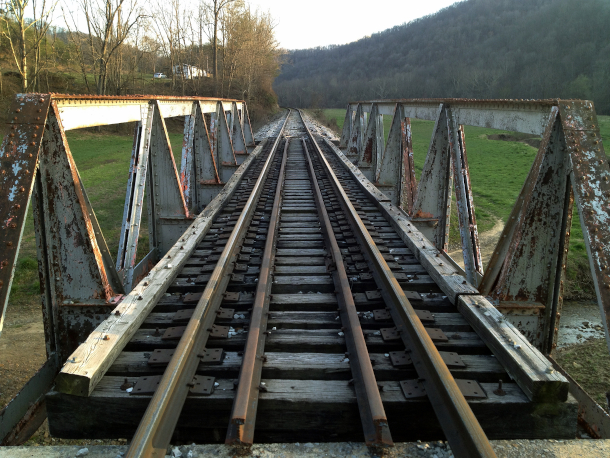
Rusting railroad tracks connecting mountaintop mines in East Tennessee, Appalachia to the rest of the U.S. American demand for coal has shrunk by 40% over the last decade. (Photo: Appalachian Voices, Flickr, CC BY 2.0)
CURWOOD: The Appalachian region of the U.S. is often called coal country. And to a large degree, coal dug out of the mountains in Western Pennsylvania, the Virginias, Eastern Ohio, and Kentucky fueled the early development of the United States. But market forces and concerns about climate changing gases from the burning of coal have forced mines across the region to shut down, leaving thousands of coal miners without work. To help revitalize the region, the United Mine Workers of America union is teaming up with the electric vehicle battery company Sparkz to bring the lithium-ion battery industry to West Virginia without using cobalt. Cobalt is scarce and expensive and its extraction from places like Central Africa is linked to humanitarian concerns including child labor. So, a cobalt free EV battery factory in Appalachia is expected to produce a less expensive and more ethical battery, address climate change, and bring much needed jobs and economic development. For more I’m joined now by Erin Bates, communications director for the United Mine Workers of America. Welcome to Living on Earth!
BATES: Hi, thank you for having me.
CURWOOD: So, the Appalachian region is known as perhaps the first home of U.S. coal. Out west in Wyoming, there's a lot of coal that's done as well there. But coal, of course, allowed this country to manufacture iron, steam engines, railroads. Now, a lot of coal mines have disappeared, especially in the East. Let's step back for a moment. Tell me, what do you think caused the industry to disappear so much? And how has it affected the communities in Appalachia?
BATES: Well, you're correct. There have been 60 coal mining companies that have either filed for Chapter 7 or Chapter 11 bankruptcy since 2012, so to say that there has been a massive decrease in jobs and in coal mining opportunities in the United States is correct; it has decreased substantially. The market was really great, you know. In 2011, we had over 92,000 coal miners, and production was high, costs were high, the companies were making a profit. But after 2011, the prices really plummeted. And it caused a lot of companies to have to, you know, liquidate their properties in order to maintain any kind of profit. Now, with bankruptcy laws in the United States, what that meant was, they would file for bankruptcy, the coal mining, the owners and operators would get massive bonuses, and the workers would be left with nothing. So, what does that do to the communities? It absolutely destroys them. When these coal mines close, what happens? They don't have the income to shop at grocery stores, they don't have the extra cash to go buy clothes at the local, you know, shops downtown, they don't have money to buy prescriptions, they don't have money to... so it doesn't just hurt the coal miners and their families, that hurts the entire community. And so, these little towns that were thriving, and were growing, are now ghost towns.
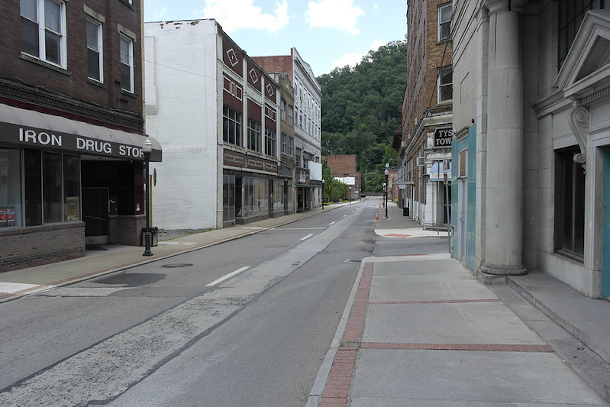
Welch, West Virginia, a town once at the heart of the 20th century coal boom, has since fallen on hard times. Hundreds of small mining towns across Appalachia have faced the same fate in the past decades. (Photo: Aaron F. Stone, Flickr, CC BY-SA 2.0)
CURWOOD: So, what's been done over this past decade to deal with that situation?
BATES: Well, the United Mine Workers has been battling these bankruptcies left and right. We have Patriot, Arch, Peabody. Right now, we're in the middle of dealing with the aftermath of Jim Walter's bankruptcy. And so, what the union has been doing has been working with the bankruptcy judges to at least try and get the benefits and the jobs that these coal miners deserve. And we've been doing that in a couple of ways. One, typically, we try to find a new buyer for the coal mine if they're not completely shutting down, and then we work to make sure that a UMWA contract is in place. Now, if that's not happening, there's just not enough jobs to go around to benefit all of the laid off workers that have been coming into play in the last decade.
CURWOOD: Now, of course, we're talking because UMWA is working alongside with Sparkz, now, on building this cobalt-free American-made lithium ion battery factory. Please, tell me about this project.
BATES: So, the owner of Sparkz, he wanted to make sure that the factory that he was building was going to be a represented facility and have union workers there, which obviously is beneficial for a lot of the people in West Virginia. We have a lot of laid off coal miners who have struggled to find new work there. So initially, they are going to bring in 300 jobs into the Appalachia area, but they are expecting for that to rise up to about 1,000 to 3,000 jobs just from that one gigafactory that they're building in West Virginia. So, we're really excited about it.
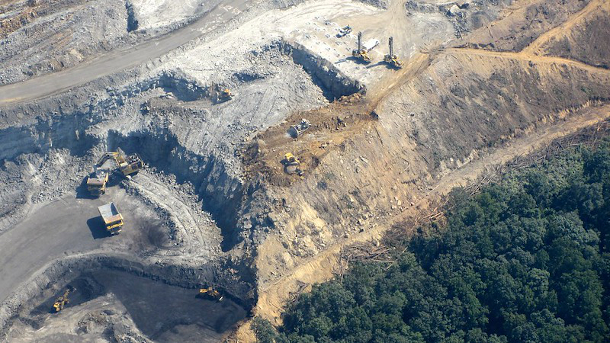
West Virginia is the second largest coal producer in the nation but coal production there has been on the decline in recent decades. (Photo: Delta Whisky, Flickr, CC BY-NC-ND 2.0)
CURWOOD: To what extent is the United Mine Workers leading the way in this huge energy transition? Because of course, along with people who work in the coal mines or people who work in the natural gas fields and oil fields, and in fact, if we were moving towards electric vehicles, there are whole parts of the automotive support field that are gonna have to change. To what extent does UMWA see itself as a beacon here, as a leader to helping society make this transition?
BATES: I think we have a huge influence on what's going to happen in the future. Because we have so many people that are going to be affected by this, we have released an initiative: it's Preserving Coal Country. And in this initiative, we're pretty much just asking the administration to take into consideration who they're going to be hurting in this transition. And we have solutions. We have ways that this can be a better transition than what they're claiming is actually going to take place. So really, what would be a huge benefit is if they actually took into consideration the plans that we have in place. We know that climate change is happening, we know that there's an issue, and so we're not naive to the fact that change needs to happen. But if jobs are not created as quickly as the administration wants to shut down these coal mines, there's gonna be several years of lapse where people don't have jobs. So, I think that the administration really needs to take a look at who they're affecting by shutting all of this down as quickly as they are without having something in place to help the families that are out there and that are going to be dealing with the consequences of this.
This agreement is a win-win for the laid-off coal miners .... We've lost thousands of mining jobs over the last decade in WV. This is a step toward putting people back to work in good, well-paying, jobs. - International President @CecilRoberts https://t.co/mDrMDBg6DO
— United Mine Workers (@MineWorkers) May 24, 2022
CURWOOD: So Erin, there have been a lot of mines now abandoned because of the shutdowns in the coal business. Some are down in the pits, some are strip mines and so-called mountaintop removal. Seems to me there'll be a lot of jobs in remediating these mines, taking care of these abandoned mines. What's UMWA doing about that? And, of course, the prospect again of job creation.
BATES: Absolutely. There are jobs that can be had by the reclamation needs that are at these abandoned mine lands. This is one of the parts that is in our initiative for Preserving Coal Country. We want the federal government to require the states to create contracts for AML reclamation and require union wages for the people that work out there. It's something that needs to be done regardless, and it’s hundreds of jobs that they could be creating just by focusing on reclamation needs for these abandoned mine lands.
CURWOOD: Erin Bates is communications director for the United Mine Workers of America. Erin, thanks for your time today.
BATES: Thank you for having me.
Related links:
- The Detroit News | “EV Battery Maker Cuts Deal To Use Displaced Coal Miners At West Virginia Plant”
- Learn more about United Mine Workers of America
- Learn more about Sparkz
- NBCNEWS | “West Virginia’s Coal Powered The Nation For Years. Now, Many Look To A Cleaner Future.”
- WV Public Broadcasting | “Coal Production Drop Off Leaves Behind Unreclaimed Mine Lands”
[MUSIC: Sambada, “Casa de Mainha” on Gente!, by Sambada, Cali-Bahia Records]
BASCOMB: Coming up – In honor of pride month we’ll chat with drag queen, hiker and environmental activist, Pattie Gonia. Keep listening to Living on Earth
ANNOUNCER: Funding for Living on Earth comes from you, our listeners, and United Technologies, combining passion for science with engineering to create solutions designed for sustainability in aerospace, building industries and food refrigeration.
[CUTAWAY MUSIC: Boubacar Traore, “Kar Kar/Vincent” on Kongo Magni, by Boubacar Traore, World Village]
Note on Emerging Science: A Sign of SIDS Risk
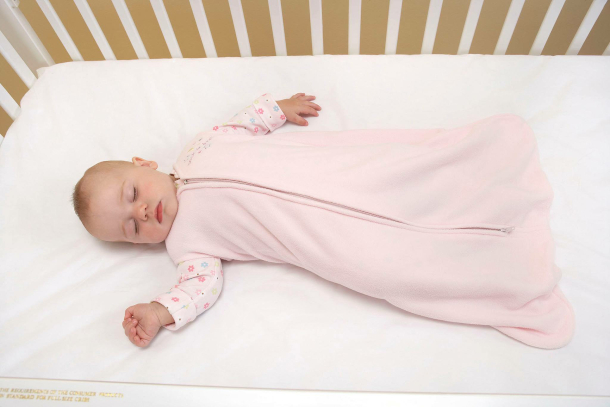
An infant sleeping on its back, following the recommendations of the Safe to Sleep campaign to reduce the risk of Sudden Infant Death Syndrome. (Photo: Eunice Kennedy Shriver National Institute of Child Health and Human Development (NICHD), Flickr, CC BY-NC-ND 2.0)
CURWOOD: It’s Living on Earth, I’m Steve Curwood.
BASCOMB: And I’m Bobby Bascomb
Coming up – a juvenile osprey learns to hunt but first this note on emerging science from Delaney Dryfoos.
[SCIENCE NOTE THEME]
DRYFOOS: More than two decades after Dr. Carmel Harrington lost her own child to sudden infant death syndrome, a study she led found a potential biochemical marker that for the first time could help identify living babies at risk. SIDS is the sudden, unexplained death, usually during sleep, of an infant younger than one year old. The number of deaths from SIDS has dropped in half since the 1990s due to a successful public health campaign to encourage parents to put babies to sleep on their backs, but it still takes the lives of more than 1,000 infants in the United States every year.
A group of researchers at The Children’s Hospital at Westmead in Australia suspected a certain enzyme might play a role in SIDS. Dr. Harrington and her colleagues assessed levels of the enzyme, butyrylcholinesterase, in the blood of babies a few days after their birth. Babies who died unexpectedly in their sleep during their first year of life were found to have lower amounts of the enzyme in their blood at birth compared to babies who survived or died of other causes.
This enzyme plays an important role in regulating the autonomic nervous system, which controls breathing, heart rate and other automatic bodily functions. Infants who die of SIDS have long been thought to possess a dysfunctional autonomous nervous system; instead of waking, gasping and crying when their blood-oxygen level dips during sleep, they remain still and cannot arouse themselves awake to breathe.
The study, however, was quite small and is only the first time that low levels of this enzyme has been correlated to SIDS in infants.
Scientists hope this new research could result in a test available at birth to determine an infant’s risk, but more research is needed to confirm these findings and ultimately use them diagnostically.
That’s this week’s note on emerging science. I’m Delaney Dryfoos.
Related links:
- Read the study
- Read about Safe Infant Sleep
- Damien’s Legacy – Dr. Carmel Harrington’s research funding
[SCIENCE NOTE THEME]
Gotta Getta Fish!
An osprey snags a fish out of the water (Photo: © Mark Seth Lender)
CURWOOD: By mid-summer many species of birds are fledging the nest and striking out to find their first meal not delivered by the beak of a parent. Living on Earth’s Explorer in Residence, Mark Seth Lender, has this story of a juvenile osprey doing just that on the Connecticut River.
Gotta Getta Fish!
Fog, drifts.
A knife-edge divides the dawn. Above, clouds and darkness. Below, the darkling sea, at rest. Quiet remnants of a storm that came in the night and left in the night. How the lightning must have terrified him, the young osprey, on the nest on his own. Where he slept alone. The first time in his life. And the night was long. And woke alone also to the terror that is hunger.
Fog lifts.
Now Young Osprey makes for the Bight. Where the eddies churn all along the sand bar and to the left and the right the signs are good. The water is cool. The bait will rise. menhaden, and snapper blues! The tide is running to the lee and the sea will be smooth as waxed stone. A place he will see for the first time all in the glow of the knife-edge line. Known before only against his feathered skin by weathers coursing over the dune front and heard, all along the shore in the waves’ roar. Beneath a sun dull as molten iron he cannot hear it anymore, only the blood, hammering in his ears:
fish – fish – fish – fish – fish – fish
Gotta catcha fish,
Gotta catcha fish,
Gotta catcha –
Tipping of the tail, Flashing of the scales
- Gotta catcha - Gotta getta - Gonna find a -
fish – fish – fish
DIVES!
- and rises -
DIVES!
- and rises -
A juvenile osprey hovers (Photo: © Mark Seth Lender)
Shaking, the water slaking, a rain of his own making, taking, his life’s force away from him a drop at a time, all for nothing. He circles then hovers the ocean covered granular and dark as emery cloth.
He must! See! Through!
Must! See! This! Through!
fish – fish – fish – fish – fish – fish
Sssss - PLOOZHHH!
Osprey struggles, falls back up to his neck and shoulders, wings outspread around him and the weight of the wet keeping him bound. While the gray of the sky and the blinding eye of day both ignore him. It is all will, he is all in, it is never, or it is NOW:
One!
Last!
Thrust!
- And in his talons -
…FISH! …FISH!
I!
GOTTA!
FISH!
CURWOOD: That’s Living on Earth’s Explorer in Residence, Mark Seth Lender. For photos of the young osprey visit the Living on Earth website, LOE dot org.
Related links:
- Mark Seth Lender’s website
- Find the field note for this essay here
- Thanks to Destination Wildlife
- Smeagull’s Guide to Wildlife
- Stewart B. McKinney National Wildlife Refuge 50th Anniversary event, July 23, 2022
[MUSIC: Craig Campbell, “Fish” on Craig Campbell, Craft Recordings]
Hiking in 6-Inch Heels
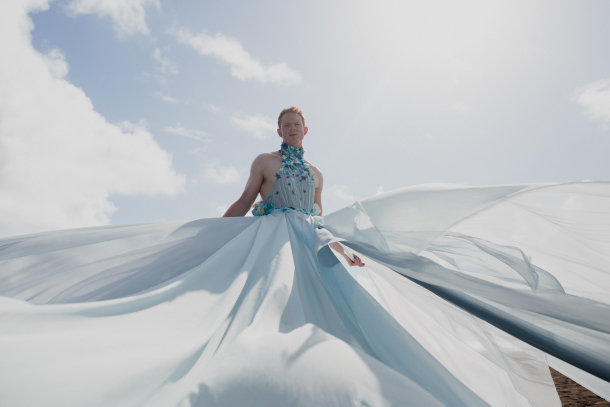
Pattie Gonia on a beach in Hawaii. (Photo: Courtesy of Pattie Gonia)
BASCOMB: June is pride month, a time when the LGBTQ community celebrates inclusion and equality. But the great outdoors is often cast in masculine terms so, queer and gender non-conforming people can sometimes feel excluded from outdoor spaces. But photographer Wyn Wiley wants to change that. Wyn spends his spare time hiking in the back country as Pattie Gonia, a drag queen, complete with wigs, exaggerated makeup and six-inch heels. Pattie posts pictures of herself on Instagram to encourage everybody, regardless of gender identity and sexual orientation, to get out and enjoy nature. She has amassed nearly half a million followers on Instagram and joins us now, in those 6-inch heels, to discuss her journey as a queer environmental activist and the solace she finds in nature. Pattie Gonia, welcome to Living on Earth.
PATTIE GONIA: Thank you for having me. I'm excited.
BASCOMB: Yeah, we're so excited to have you. Growing up in Nebraska. What was your relationship like with the environment, with the natural world around you?
PATTIE GONIA: Yeah. Growing up in Nebraska, I had nature all around me, I lived my life at my grandma's farm and in my backyard. And there's no more vivid memory of childhood than like the giant oak tree in my backyard and the swing attached the oak tree. And I also spent a lot of time growing up in Boy Scouts and that brought me outdoors as well.
BASCOMB: Now today, you're putting together your love of nature and your expression of yourself through drag. Can you tell us about that, about hiking outdoors in full drag regalia? What does that look like? And how does it feel for you?
Wyn created Pattie Gonia two years ago and has accumulated over 300,000 follows on the account’s Instagram page. (Photo: Courtesy of Pattie Gonia)
PATTIE GONIA: I feel very lucky that my passions get to intersect so much. I really feel like for anyone in life when you can get a chance to intersect your passions, and kind of Venn diagram one circle over the other and find that middle, ooey gooey like good zone, it's so wonderful. I feel so alive. So, when I do drag in the outdoors I feel the most me. And yes, that means literally backpacking in high heels, which you can think is a very silly and stupid and dangerous thing but so is riding a mountain bike down a mountain at 45 miles an hour. So, you know pick and choose your danger in the outdoors. I just choose to wear some six-inch heels, but it's really beautiful for me to get to also be very feminine and be in touch with my femininity in a space I feel is very feminine. And I feel like we're told through media, through just the narratives and through the archetypes in the outdoors that the outdoors are a very masculine space. They're very, they're there to conquer, and I enjoy being with them, and I enjoy making art with them. It totally changes my experience with the outdoors when I'm in drag as well. I feel like I noticed things I wouldn't out of drag.
BASCOMB: Really like what?
PATTIE GONIA: You know when you sit, and you do your makeup for three hours and you're in one place, you just notice a lot of things. You notice the birds. You notice the flowers around you. I think I spent so much of my life, especially pre-quarantine going at such a fast pace. And I think when you're out on the trail you also can go such a fast pace even though you're walking, you know, you're you're going by so much so fast. And I feel like when I'm sitting there, I can just notice what's actually around me and can realize how much of a, how much of like a symphony at all is how much everything has a purpose, myself too.
BASCOMB: And what inspired you to start doing drag to begin with?
PATTIE GONIA: I think what inspired me to do drag was finally wanting to do it for myself. I grew up in Nebraska, in an incredibly beautiful environment, but one that basically was told to me only accepted me if I was straight passing. So, when I came out, it was conditional love. It was, hey, we love you. This is beautiful. We accept you for who you are, but never do drag but never want to transition to be a female. But never, this never that. Don't change your voice. Don't don't have a feminine voice. So, I think drag for me was the release of kind of a lot of toxicity that I'd internalized since initially coming out. And just falling in love more and more with drag ever since. I'm fascinated with the freedom that I feel when I'm a drag.
Many of Pattie’s looks, like this one, are inspired by animals, plants, and the great outdoors. (Photo: Courtesy of Pattie Gonia)
BASCOMB: And so, for someone that hasn't seen your Instagram posts, can you describe a typical outfit that you might wear on the trail or even a favorite outfit that you've worn that would really give people an image in their mind?
PATTIE GONIA: Absolutely. So, I just want you to think of the most absolutely absurd things you could ever imagine a drag queen to wear and that's literally what I'm wearing. So, one of my favorite outfits is actually made by one of my friends, Angela, and the dress is actually a full functioning tent. You can take off the dress, you can literally put poles in it and it turns into a tent. I'm not kidding. So, she originally designed it as a jacket that was used to basically bring up the conversation of refugees. So, she's made hundreds of these coats to give to refugees to be able to have as jackets slash coats and also as tents that they can sleep in as well. But we're repurposing it for the outdoors as well. So, it's fun. I think it's definitely fun to just have fun with fashion to not take it too seriously. Some of my favorite looks are things I throw together like that. And or I have a piece that I want to show and tell with you that I want to describe for listeners.
BASCOMB: Yeah, please. That'd be great.
PATTIE GONIA: So, so this is a wig made of over 100 pieces of plastic.
BASCOMB: Woah, looks like a giant disco ball of plastic.
PATTIE GONIA: Yes, it is very, I think very like Amadeus. Like, like very much queen, old royalty, like can we create a two-foot-tall wig on a head? Yes, we can. And let's do that of plastic. So, this is all differently like upcycled plastic items. And I'm going to set the phone down just so that I can put it on and then I'll pick up the phone again. So, give me one second.
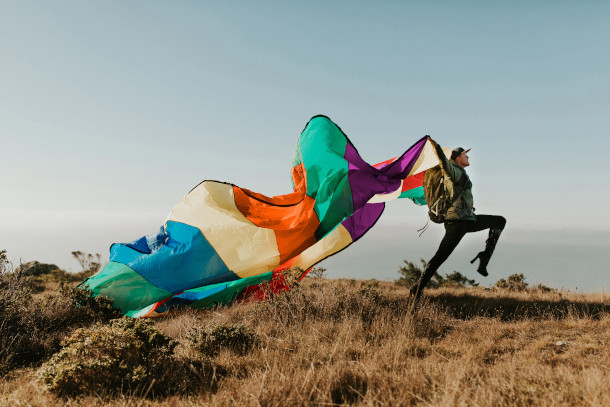
Pattie showing off her six-inch heels. (Photo: Courtesy of Pattie Gonia)
BASCOMB: Perfect yeah.
PATTIE GONIA: Okay, just so you can see the full effect.
BASCOMB: Perfectly I love it.
PATTIE GONIA: Okay, so this is it. It literally looks like I am wearing just a giant stacked pile of trash on my head because I am.
BASCOMB: Well it looks very, you know, Marie Antoinette to me, you know, like back in that era, there was so over the top with things like that weren't even trying to look real.
PATTIE GONIA: Absolutely. And it's great it like, ruffles in the wind, like you can kind of hear it. We'll do some ASMR. Something I'm thinking about all the time is that drag as a culture is inherently very wasteful. And I'm really trying to deconstruct drag for the purpose of making it as sustainable as can be. So, this is a wig made of plastic because plastic wigs you see drag queens wear that look like real hair are literally plastic. So why am I putting new plastic into the world rather than wearing trash? So, I am a trashy queen. Here I am.
BASCOMB: Love it.
PATTIE GONIA: So, I'm gonna take this off because it's gonna be like audio interference. But yeah.
BASCOMB: It doesn't look too comfortable, either.
PATTIE GONIA: It's actually really comfortable. It's -
BASCOMB: Really?
PATTIE GONIA: One of my most comfortable wigs. Yeah, it's amazing.
Pattie’s short film, Dear Mother Nature about being herself in the outdoors was nominated for several awards. (Photo: Courtesy of Pattie Gonia)
BASCOMB: Yeah, super fun. And what kind of reactions do you get from other people on the trail that are probably not expecting to run into a drag queen? Well, you know, out and about in the woods?
PATTIE GONIA: Absolutely. Um, it's always a mixed bag. I'm fascinated with how much even just wearing heels even if they're not in for drag, but just hiking in heels, is such a disarming moment, like people will, it'll catch them off guard and notice the heels and they'll light up inside and they're like, oh my gosh, hi. Whoa. And it's always a conversation starter. Of course. It's not like you see people walking in six-inch heels out in nature. But I think it's a really beautiful touch point to learn. And I love opening up conversation with people if they're open to it on the trail, but I've definitely had and experience homophobia on the trail, too. I've definitely not felt comfortable at many points on the trail, especially when I'm more in full form drag, have been called a circus act on the trail. I've been called other words we will not say on public radio, so it's a mixed bag. But I'm amazed at how often it's a positive interaction.
BASCOMB: You know, we've had a few segments on Living on Earth recently about people of color, enjoying the outdoors, and I'm sure you're familiar with the story of Christian Cooper, the African American man who was birding in Central Park when a white woman called the police on him after he asked her to leash her dog. You know, people of color routinely report feeling unsafe or unwelcome in the outdoors. How does that sentiment resonate with you as a queer person, as a drag queen?
PATTIE GONIA: Absolutely. I think the practice of drag really lets me know that the hate that I face and the homophobia that I face is a sliver of what people of color experience, is a sliver of what my trans and non-binary queer community members experience on the trail. It's a very different experience in a very privileged experience that underneath drag, I am a white, straight-passing male. And that's something I'm thinking about all the time. And thinking about how much drag really lets my queerness unfold. But the privilege it is to be able to wipe off makeup at the end of the day, the privilege to be able to pack away my heels and have no one know about my difference or about that I'm a member of a marginalized community. So, I think it's a really, really interesting practice. And I'm not at all comparing my experience to theirs, but it literally does very much let me know how much work we have to do in the outdoors to truly make them an inclusive place for everybody.
BASCOMB: And why do you think it's important to see queer people in the outdoors?
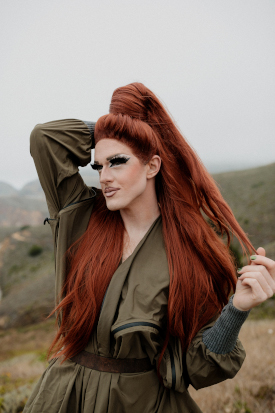
Pattie describes herself as an intersectional environmentalist. (Photo: Courtesy of Pattie Gonia)
PATTIE GONIA: I think it's important to see queer people in the outdoors, because nature is so queer itself. Because queer people are people too. Because if the outdoors can't be a place where we celebrate diversity, something that Mother Nature knows is absolutely key. For the longest time, I didn't see myself represented in the queer community because I'm not a person that's going to spend their Friday or Saturday night in a bar or club. And I'm not dogging that. I'm just saying, I'm going to be out on the trail. I'm gonna be out camping. And so, I've been really thankful for this journey with Pattie to really remind me how much we can create queer community in the outdoors and how important that is and how many queer people were already out there in the outdoors. We just didn't have as many campfires to kind of gather around.
BASCOMB: Wynn Wildly is Pattie Gonia, intersectional environmentalist and self-described fetus drag queen. Thank you so much for taking this time with me and sharing your story.
PATTIE GONIA: Thank you so much for letting one of my baby steps as a drag queen be being on your show.
Related links:
- Pattie Gonia’s Instagram page
- Dear Mother Nature, featuring Pattie Gonia
[MUSIC: Yonji Visomoku/Kim Miguel, “Dance the Night Away” by Van Halen, Cry Baby Records]
CURWOOD: Living on Earth is produced by the World Media Foundation. Our crew includes Naomi Arenberg, Paloma Beltran, Chloe Chen, Iris Chen, Josh Croom, Jenni Doering, Delaney Dryfoos, Mark Kausch, Mark Seth Lender, Don Lyman, Louis Mallison, Aynsley O’Neill, Sophia Pandelidis, Jake Rego, Hannah Richter, and Jolanda Omari. We bid a fond farewell to Teresa Shi, thanks for all your hard work, Teresa!
BASCOMB: Tom Tiger engineered our show. Alison Lirish Dean composed our themes. Special thanks this week to the Stuart B. McKinney Wildlife Refuge, now celebrating its 50th anniversary. You can hear us anytime at L-O-E dot org, Apple Podcasts and Google Podcasts, and like us, please, on our Facebook page - Living on Earth. We tweet from @livingonearth. And find us on Instagram @livingonearthradio. I’m Bobby Bascomb.
CURWOOD: And I’m Steve Curwood. Thanks for listening!
ANNOUNCER: Funding for Living on Earth comes from you, our listeners, and from the University of Massachusetts, Boston, in association with its School for the Environment, developing the next generation of environmental leaders. And from the Grantham Foundation for the protection of the environment, supporting strategic communications and collaboration in solving the world’s most pressing environmental problems.
ANNOUNCER 2: PRX.
Living on Earth wants to hear from you!
Living on Earth
62 Calef Highway, Suite 212
Lee, NH 03861
Telephone: 617-287-4121
E-mail: comments@loe.org
Newsletter [Click here]
Donate to Living on Earth!
Living on Earth is an independent media program and relies entirely on contributions from listeners and institutions supporting public service. Please donate now to preserve an independent environmental voice.
NewsletterLiving on Earth offers a weekly delivery of the show's rundown to your mailbox. Sign up for our newsletter today!
 Sailors For The Sea: Be the change you want to sea.
Sailors For The Sea: Be the change you want to sea.
 The Grantham Foundation for the Protection of the Environment: Committed to protecting and improving the health of the global environment.
The Grantham Foundation for the Protection of the Environment: Committed to protecting and improving the health of the global environment.
 Contribute to Living on Earth and receive, as our gift to you, an archival print of one of Mark Seth Lender's extraordinary wildlife photographs. Follow the link to see Mark's current collection of photographs.
Contribute to Living on Earth and receive, as our gift to you, an archival print of one of Mark Seth Lender's extraordinary wildlife photographs. Follow the link to see Mark's current collection of photographs.
 Buy a signed copy of Mark Seth Lender's book Smeagull the Seagull & support Living on Earth
Buy a signed copy of Mark Seth Lender's book Smeagull the Seagull & support Living on Earth

